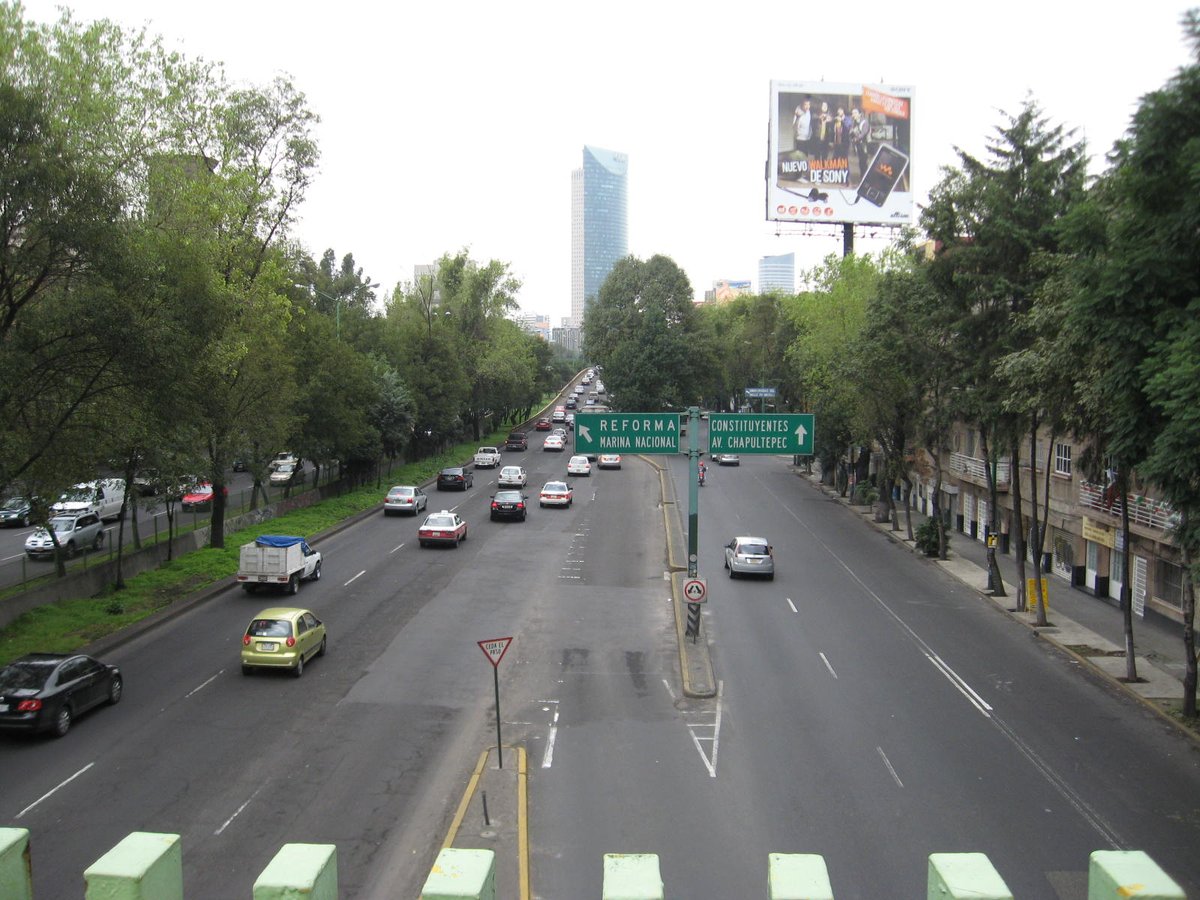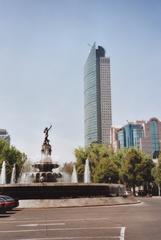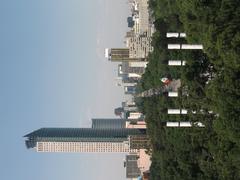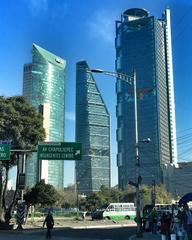
Torre Mayor Mexico City: Visiting Hours, Tickets, and Essential Tips
Date: 14/06/2025
Introduction
Torre Mayor is a landmark of modern Mexico City, representing a fusion of advanced engineering, architectural innovation, and urban regeneration. Located on the historic Paseo de la Reforma, Torre Mayor is not only an office skyscraper but also a symbol of seismic resilience and sustainable development. Since its completion in 2003, it has stood as a testament to Mexico City’s forward-thinking approach to urban challenges, especially in the aftermath of the devastating 1985 earthquake. This comprehensive guide provides detailed information on Torre Mayor’s history, engineering feats, visiting hours, ticketing options, accessibility, and tips for maximizing your experience near this iconic skyscraper.
Table of Contents
- Historical Background and Architectural Significance
- Visitor Information
- Key Facts and Figures
- Visitor FAQ
- Conclusion and Recommendations
- References and Further Reading
Historical Background and Architectural Significance
Origins and Urban Context
Torre Mayor was constructed on the prestigious Paseo de la Reforma, a boulevard originally designed in the 19th century to emulate European capitals (Obras Expansión). The site previously housed the Cine Chapultepec, a beloved cultural venue, reflecting the area’s long-standing role as a social and cultural hub (Archello). The decision to build Torre Mayor here was strategic, aiming to position Mexico City as a modern financial capital, particularly in the wake of the 1985 earthquake, which heightened concerns about the feasibility of high-rise construction in such a seismic zone (Structure Magazine).
Engineering and Design Innovations
Designed by Zeidler Partnership and Adamson Associates, Torre Mayor’s structure is a benchmark in seismic engineering. It employs a combination of braced perimeter frames, a moment frame tube, and a trussed core, integrated with over 96 viscous dampers in a patented diamond-shaped configuration (Scribd). These dampers, originally designed for military use, allow the building to withstand earthquakes up to magnitude 8.5. The effectiveness of this system was proven during a 7.6-magnitude earthquake in 2003, when the tower remained unharmed and occupants barely felt the tremor (Structure Magazine; Wikipedia).
The building’s form, a blend of square and elliptical shapes, maximizes views and sunlight. The south façade, clad in blue-green reflective glass, offers thermal and acoustic insulation, while the north side features red granite, anchoring the tower visually within the city (Adamson Associates). Public and common spaces are finished with marble and granite, and the interiors are customizable for tenants (Obras Expansión).
Sustainability and Environmental Leadership
Torre Mayor is a pioneer in sustainable practices, earning LEED certification in 2013 (Wikipedia). Features include a Building Management System (BMS) for efficient resource use, solar energy integration, water-saving fixtures, fresh air exchange systems, and strict waste management standards. The building was the first in Mexico to meet the NOM-008 energy efficiency standard for nonresidential buildings (Obras Expansión).
Urban Impact and Legacy
Upon opening, Torre Mayor was the tallest building in Latin America, transforming Mexico City’s skyline and catalyzing the vertical growth of the financial district (Archello). It spurred urban regeneration along Paseo de la Reforma, raising property values and inspiring subsequent high-rise developments. Its reputation for seismic safety—“the building people run into during an earthquake”—has made it a beacon of innovation (Structure Magazine).
Visitor Information
Visiting Hours and Access Policies
Torre Mayor functions primarily as a commercial office building with limited public access. The lobby and ground-floor retail spaces are generally open to the public Monday to Friday, 7:00 AM to 7:00 PM. There is currently no regular public access to the observation deck or office floors. Public entry beyond the lobby is restricted to tenants, their guests, or attendees of special events.
During citywide festivals or architecture events (such as Open House CDMX), guided tours or special exhibitions may be offered. These opportunities are announced in advance and require registration (official Torre Mayor website).
Tickets and Entry Procedures
No tickets are needed to access the lobby or ground-floor amenities. For special events or guided tours, advance registration and a government-issued photo ID are required. Security protocols include bag checks and restrictions on large items. Only registered guests or those with business appointments will be permitted beyond public areas.
Facilities and Accessibility
- Retail & Dining: Cafés, bakeries, and casual dining options are available on the ground floor during business hours.
- Restrooms: Clean, accessible restrooms are located in public zones.
- Wi-Fi: Complimentary Wi-Fi is available in select public areas.
- Accessibility: The tower is fully accessible, with ramps, wide elevators, tactile paving, Braille signage, and adapted restrooms. Assistance is available upon request.
Guided Tours and Special Events
Torre Mayor occasionally hosts guided architectural tours during city events. These tours focus on the building’s seismic design, sustainability practices, and urban significance. Capacity is limited and advance booking is essential. Photography is generally restricted but may be allowed in designated areas during tours.
Nearby Attractions and Connectivity
Torre Mayor’s location on Paseo de la Reforma provides easy access to major Mexico City attractions:
- Chapultepec Park: Museums, a zoo, and green spaces.
- Museo Nacional de Antropología: Renowned for its pre-Hispanic collections.
- Monumento a la Independencia (El Ángel): Iconic city landmark.
- Polanco and Condesa districts: Dining, shopping, and nightlife.
Public transit options include Metro lines (Chapultepec and Sevilla stations), Metrobus, city buses, and Ecobici bike-sharing stations. The area is pedestrian-friendly, with wide sidewalks and crosswalks.
Parking and Transportation
Torre Mayor offers underground parking with approximately 2,000 spaces, primarily for tenants and those with prior authorization. Public parking in the vicinity is limited and fills quickly during peak hours. Visitors are encouraged to use public transportation, taxis, or rideshare services for convenience.
Key Facts and Figures
- Height: 225 meters (738 feet)
- Floors: 55
- Completion: 2003
- Seismic Dampers: 96 viscous dampers in diamond configuration
- Earthquake Resistance: Up to magnitude 8.5
- LEED Certification: Achieved in 2013
- Elevators: 29 passenger elevators, top speed 6.7 m/s
- Parking: 2,000 spaces
- Retail Space: 150,000 square feet
- Daily Users: Over 9,000 people work in the building (Obras Expansión)
Visitor FAQ
Q: Can I visit the Torre Mayor observation deck?
A: The observation deck is permanently closed to the public. Special access to upper floors may be available during certain events.
Q: Are there guided tours of Torre Mayor?
A: Public guided tours are only available during special events, such as Open House CDMX, and require advance registration.
Q: Is Torre Mayor accessible for visitors with disabilities?
A: Yes. The building is fully accessible with ramps, adapted restrooms, tactile paving, and elevators with Braille and auditory signals.
Q: Is parking available for visitors?
A: There is underground parking, but most spaces are reserved for tenants and authorized visitors. Public parking is limited.
Q: What are the building’s opening hours for visitors?
A: The lobby and ground-floor amenities are open Monday to Friday, 7:00 AM to 7:00 PM.
Q: Can I take photos inside Torre Mayor?
A: Photography is generally restricted except in designated areas during special tours or events.
Visuals and Interactive Elements
- Image: Torre Mayor exterior with reflective glass façade (alt: “Torre Mayor skyscraper in Mexico City with reflective glass façade”)
- Image: Panoramic city view from nearby vantage points (alt: “Mexico City skyline view near Torre Mayor”)
- Image: Seismic viscous dampers (alt: “Seismic dampers inside Torre Mayor ensuring earthquake resistance”)
- Map: Torre Mayor’s location and nearby Metro stations (alt: “Map of Torre Mayor and nearby public transit”)
- Virtual Tour: Available on the official Torre Mayor website
Conclusion and Recommendations
Torre Mayor is an outstanding example of Mexico City’s commitment to resilience, innovation, and sustainable urban growth. While public access is currently limited to the lobby and ground-floor amenities, the tower remains a must-see landmark for architecture enthusiasts and urban explorers. If you are interested in Torre Mayor’s engineering and design, plan your visit around citywide events for exclusive access, and make use of public transportation for convenience. Enhance your experience by using the Audiala app for real-time updates, audio guides, and travel tips.
For more on Mexico City’s modern skyline and historical sites, consult the related articles and external resources below.
References and Further Reading
- Obras Expansión, 2023, Architecture Feature on Torre Mayor (Obras Expansión)
- Structure Magazine, Structural Design Challenges for Tall Buildings in Mexico City (Structure Magazine)
- Wikipedia, Torre Mayor (Wikipedia)
- Edificios de México, Torre Mayor Overview (edemx.com)
- Official Torre Mayor Website (official Torre Mayor website)
- Archello, Torre Mayor Project (Archello)
- Adamson Associates, Torre Mayor Project (Adamson Associates)
- Mexico Historico (Mexico Historico)













































































































































































